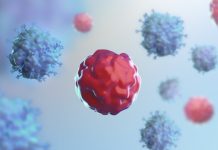
Researchers have made a significant breakthrough in the development of an intranasal COVID-19 vaccine.
Scientists from Lancaster University have carried out pre-clinical trials of a COVID-19 vaccine which can be administered through the nose. The results of the trials showed a reduction in both the impact of COVID-19 itself and transmission of the virus.
The findings of the study have been published in the journal, iScience.
The research team immunised hamsters with two doses of the vaccine, and found they showed complete protection from lung infection, inflammation, and pathological lesions following exposure to the SARS-CoV-2 virus.
Researchers observed that two doses of the intranasal vaccine were found to significantly reduce the virus “shedding” from the nose and lungs of the hamsters – suggesting that the vaccine has the potential to control infection at the site of inoculation.
Potential to limit disease and reduce transmission
Virologist Dr Muhammad Munir led the study and worked alongside a team of scientists from Lancaster University, in collaboration with researchers from Texas Biomedical Research Institute, USA.
Dr Munir said: “Our studies demonstrate that induction of a local immune response at the point of entry of SARS-CoV-2 has the potential to not only limit clinical disease, but also – and perhaps even more importantly – virus transmission from infected to uninfected individuals.”
While injectable vaccines are offering a significant reduction in hospitalisation and death, there is currently no registered intranasal vaccine against COVID-19.
Dr Munir said: “After we administered the vaccine into the noses of hamsters and then infected them with SARS-CoV-2, we found almost no virus replication in the lungs and nasal wash of these animals. In contrast, animals given normal NDV showed easily detectable SARS-CoV-2 virus replication in their lungs and nasal washes.”
The vaccine is based on a common poultry virus called the Newcastle Disease Virus (NDV), which can replicate in humans but is harmless. The scientists engineered NDV to produce the spike proteins of the SARS-CoV-2 virus which causes COVID-19, tricking the body into mounting an immune response against SARS-CoV-2. The vaccine induced neutralising antibodies in animals against several novel variants of SARS-CoV-2, raising the possibility of broad protection in vaccinated individuals.
Professor Jo Rycroft-Malone, Dean of the Faculty of Health and Medicine at Lancaster University, said: “This is an exciting next step in the development of a vaccine for COVID-19 which has the potential to increase the accessibility of a vaccine for people at home and around the world.”
Texas Biomedical Research Institute Professor Luis Martinez-Sobrido said: “The hamster animal model developed at Texas Biomed for SARS-CoV-2 studies provided a robust avenue for testing this intranasal vaccine, which is showing promising results. Our study showed that this intranasal vaccine was safe and effective, providing the hamsters protection against SARS-CoV-2.”
Dr Lucy Jackson-Jones, a Lecturer at Lancaster University, said: “We are excited by the scalability of this nasal vaccine which we hope will contribute to reducing vaccine inequity, allowing equal access to vaccination globally. Nasal delivery is also a more appealing delivery route for use in children.”
Dr John Worthington of Lancaster University said: “We are all aware of the continuing potential for variants to appear that may undo all of the amazing work the NHS has done in rolling out current vaccines. Early results suggesting reduced transmission coupled with the known ease of production, temperature storage and patient delivery of this vaccine may make a real difference in fighting the pandemic on the required global scale.”
A vaccine nasal spray offers several advantages over conventional approaches including non-invasive administration, the induction of local immunity, as well as being an alternative for people afraid of needles. This vaccine could also provide a low-cost alternative for the developing world, as it can be scaled up using the existing global infrastructure currently in use for influenza virus vaccines, offering the most economical vaccine supply worldwide.








